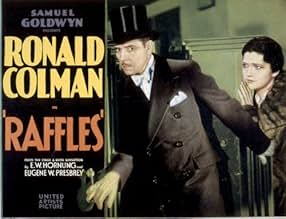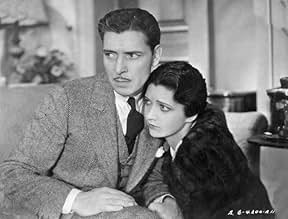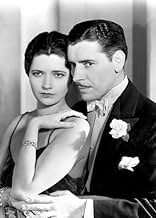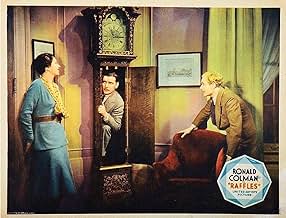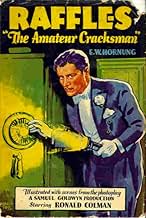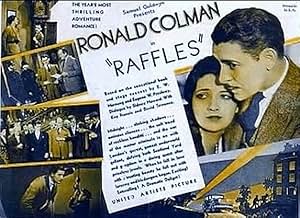Raffles
- 1930
- 1h 12min
Aggiungi una trama nella tua linguaA distinguished English gentleman has a secret life--he is the notorious jewel thief the press has dubbed "The Amateur Cracksman". When he meets a woman and falls in love he decides to "reti... Leggi tuttoA distinguished English gentleman has a secret life--he is the notorious jewel thief the press has dubbed "The Amateur Cracksman". When he meets a woman and falls in love he decides to "retire" from that life, but an old friend comes to him with a predicament that entails him com... Leggi tuttoA distinguished English gentleman has a secret life--he is the notorious jewel thief the press has dubbed "The Amateur Cracksman". When he meets a woman and falls in love he decides to "retire" from that life, but an old friend comes to him with a predicament that entails him committing one last job.
- Regia
- Sceneggiatura
- Star
- Candidato a 1 Oscar
- 2 vittorie e 1 candidatura in totale
- Lord Harry Melrose
- (as Frederic Kerr)
- Lord Melrose's Butler
- (non citato nei titoli originali)
- Harry - Lord & Lady Melrose's Friend
- (non citato nei titoli originali)
- Gwen's Friend
- (non citato nei titoli originali)
- Party Guest
- (non citato nei titoli originali)
Recensioni in evidenza
Moreover, as another character chimes, one, indeed, can't help liking Colman's Raffles. The supporting cast is decent, too, including Kay Francis as the romantic interest, David Torrence as the Scottish Scotland Yard inspector, and Alison Shipworth and Frederick Kerr are amusing as the bickering hosts to their home of guests spending the weekend, apparently, smoking, drinking and playing cricket and tennis--the sort of upper-class soirées one might expect from an episode of "Downton Abbey," where dandies in tuxedos sip brandy and retort that Americans are too savage to understand cricket.
I think what raises "Raffles" above many other early talkies, however, is the talent Samuel Goldwyn assembled behind the scenes, namely cinematographers George Barnes (5-time Oscar nominee) and Gregg Toland (who also photographed the 1939 version and is most famous for "Citizen Kane" (1941)) and art directors Park French and William Cameron Menzies (the latter of whom would invent the job of production designer during the making of "Gone with the Wind" (1939)). There's nothing amateurish in their design of the amateur cracksman's first heist scene, with the policeman's shadow lurking in the background behind store-front glass as a safe is cracked with the aid of a diegetic light source. Some camera movement is managed, too, including a nice shot of Colman on the staircase upon seeing Francis's entry. Being England, there's also a fog-filled sequence. There's nothing amazing about any of this, but it's worth noting how much difference to a slight scenario burdened by primitive new technology can benefit from skilled artists behind the camera while placing charming actors in front of it, as well as giving some thought to how to use and not use the newfangled sound.
Raffles the English gentleman has a discreet sideline as a burglar and jewel thief. The press has dubbed him 'The Amateur Cracksman', and as such he has become a household name. Now that he has fallen in love with the sophisticated Gwen (Kay Francis) and proposed marriage to her, Raffles has decided to retire from crime. However, his old pal Bunny is in a spot of bother. Bunny has been playing cards again, and has run up a gambling debt of £1,000. If Bunny is to be rescued from his predicament, Raffles will have to take on the Melrose 'job' ...
Ronald Coleman gives us his trademark suave Englishman in the title role. We see him burgling a jeweller's shop wearing a top hat (note the excellent Toland touch of the policeman silhouetted against the window drape). Our first real glimpse of the hero comes on the dance floor as he sweeps Gwen around in a romantic waltz. On the cricket field at Lord Melrose's place, Raffles is of course dashing, and wins the game (even though he was not supposed to be playing - he invited himself along for the weekend at the last minute). Even when Inspector Mackenzie has him on the ropes, Raffles remains the epitome of poise and wit.
"All bubbles and froth - no taste," says Lord Melrose, giving his verdict on champagne. It is a reasonable comment on the film itself, which for all its pretensions to style is basically an inelaborate crime flick. We have the 'two Englands' crudely juxtaposed - one urban and ugly (the cloth-capped burglars from the pub, the 'pea soup' fog in London) and the other bucolic and 'refayned' (Lady Melrose's soiree). The film takes it for granted that the lower classes are unpleasant.
However, there are good things in this movie. The cricket match is fun, and tolerably well done, though Raffles' bowling action is highly dubious and the umpire's position would make lbw decisions interesting to say the least. The skylight scene on Raffles' apartment roof is an arresting image.
There is also a large portion of baloney. Does Scotland Yard protect country houses against burglary? Is this best done by surrounding them with a dozen detectives throughout the night? Why don't these detectives catch the various burglars who enter the premises? If closing the sash window is enough to stop the burglar alarm from ringing, then it isn't much of a burglar alarm. The 'common' burglars crouch in the shrubbery and talk aloud, spelling out their plans in pedantic detail, conveniently allowing Raffles to overhear. Is it not slightly more probable that they would have worked out what to do before entering the property?
The film ends in a flurry of increasingly silly activity. Blatant undercranking of the camera makes Raffles' escape dash look ridiculous, and his place of concealment is laughable.
Verdict - An enjoyable crime caper with absurd elements.
Ah, but it stars 'The Voice', Ronald Colman, and that makes all the difference. Colman and his mellifluous voice glide through every scene and anesthetizes an unbelievable story just by talking. Here he was at the height of his popularity as the dashing cricketer/thief and has as his leading lady Kay Francis, one of the loveliest stars of that era. She is unfortunately given little to do in a meager role as his fiancé. But there are some other Hollywood stalwarts in the cast, among them Alison Skipworth in one of her ditzy socialite roles and silent film bad guy David Torrence, a Scotsman with a thick Scottish accent, as the investigating detective. Also Bramwell Fletcher and Frederick Kerr, a very elderly gentleman I found delightful in "Waterloo Bridge (1930)" in the same blustery, old duffer-type role.
"Raffles" is uncomplicated and good fun, and about as deep as a dish of water, but worth your time to see and hear Colman say things - doesn't matter what, just listen to him talk. Thank TCM for dusting this one off.
The Raffles stories were extremely popular and have been the subject of many film, theater, and television treatments. One of the best of these is this 1930, very early talkie starring cinema's quintessential English gentleman, Ronald Coleman. It's really quite a good film for its time, with an intelligent script, generally good acting (especially by Coleman and character actor Frederick Kerr, better known as Baron Frankenstein in James Whale's famous 1931 treatment of the monster story, who steals every scene he is in as a grouchy English lord.) Co-cinematographer Gregg Toland, who later worked on many Hollywood classics, is presumably responsible for the film's noirish, atmospheric lighting effects.
All in all, I'd say this entertaining film will still be enjoyed by today's audiences, and is a must see for fans of Coleman.
"Raffles" is about a gentleman who is also an amateur thief--and a very talented one. While his society friends adore Raffles (played by Ronald Colman at his charming best) because of his wit, sporting skills and fine manners, they don't realize HE is this thief. Much of the film concerns his attending a particular weekend party in order to steal a necklace so he can use the money to help a friend in dire straits. However, along the way he meets up with a swanky lady (Kay Francis) and he's torn between his life of crime or becoming 100% legitimate for her sake. What will Raffles do? And what will Raffles do when ANOTHER crook shows up as well?! All in all, "Raffles" is a pleasant and a bit too talky film. Personally, I think it would have been better with more outdoor scenes and action. But again, 1930 was still a transitional year for sound and the stagy production was pretty typical. I also thought Raffles' 'brilliant' escape at the end was anything but. However,the acting was good and it was nice to see a detective who was NOT stupid (a common and rather dumb cliché of the 1930s and 40s). Well worth seeing but not among Colman's best work.
Lo sapevi?
- QuizThe last Samuel Goldwyn movie to be shot simultaneously in silent and talkie versions.
- BlooperWhen the alarm goes off and the cat burglar is attempting to escape, Bunny's bedroom windows are show to be wide open, which would have prevented the alarm being set in the first place.
- Citazioni
Inspector McKenzie: Good heavens! In the tobacco! Well, I'll be...
A.J. Raffles: Yes, I thought that you would be.
- Versioni alternativeRaffles (1930) was made simultaneously in silent and talking versions. With almost all the theaters in the USA wired for sound, this was to be the last film that Samuel Goldwyn produced in this manner.
- ConnessioniReferenced in Simpatica canaglia (1936)
- Colonne sonoreThe Blue Danube
(uncredited)
Written by Johann Strauss
Heard when Raffles takes Lady Melrose to her room.
I più visti
- How long is Raffles?Powered by Alexa
Dettagli
- Data di uscita
- Paese di origine
- Lingua
- Celebre anche come
- Herr Raffles gör visit
- Luoghi delle riprese
- Azienda produttrice
- Vedi altri crediti dell’azienda su IMDbPro
Botteghino
- Lordo Stati Uniti e Canada
- 1.000.000 USD
- Tempo di esecuzione
- 1h 12min(72 min)
- Colore
- Mix di suoni
- Proporzioni
- 1.20 : 1

